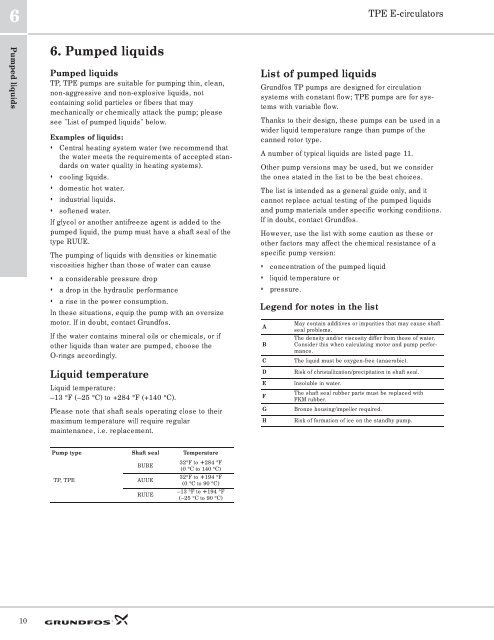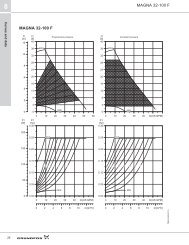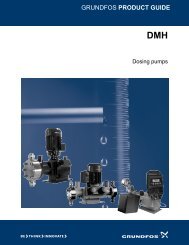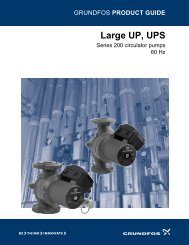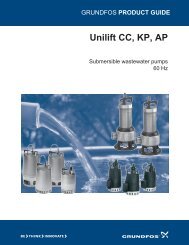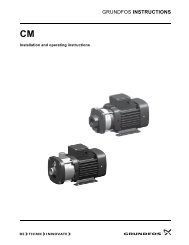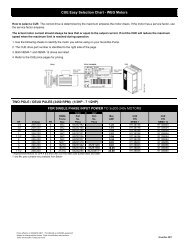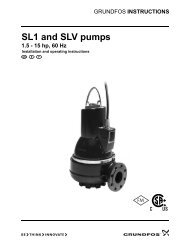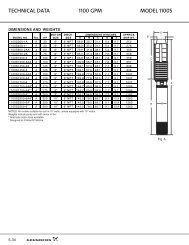You also want an ePaper? Increase the reach of your titles
YUMPU automatically turns print PDFs into web optimized ePapers that Google loves.
6<br />
<strong>TPE</strong> E-<strong>circulators</strong><br />
Pumped liquids<br />
6. Pumped liquids<br />
Pumped liquids<br />
TP, <strong>TPE</strong> pumps are suitable for pumping thin, clean,<br />
non-aggressive and non-explosive liquids, not<br />
containing solid particles or fibers that may<br />
mechanically or chemically attack the pump; please<br />
see "List of pumped liquids" below.<br />
Examples of liquids:<br />
• Central heating system water (we recommend that<br />
the water meets the requirements of accepted standards<br />
on water quality in heating systems).<br />
• cooling liquids.<br />
• domestic hot water.<br />
• industrial liquids.<br />
• softened water.<br />
If glycol or another antifreeze agent is added to the<br />
pumped liquid, the pump must have a shaft seal of the<br />
type RUUE.<br />
The pumping of liquids with densities or kinematic<br />
viscosities higher than those of water can cause<br />
• a considerable pressure drop<br />
• a drop in the hydraulic performance<br />
• a rise in the power consumption.<br />
In these situations, equip the pump with an oversize<br />
motor. If in doubt, contact <strong>Grundfos</strong>.<br />
If the water contains mineral oils or chemicals, or if<br />
other liquids than water are pumped, choose the<br />
O-rings accordingly.<br />
Liquid temperature<br />
Liquid temperature:<br />
–13 °F (–25 °C) to +284 °F (+140 °C).<br />
Please note that shaft seals operating close to their<br />
maximum temperature will require regular<br />
maintenance, i.e. replacement.<br />
List of pumped liquids<br />
<strong>Grundfos</strong> TP pumps are designed for circulation<br />
systems with constant flow; <strong>TPE</strong> pumps are for systems<br />
with variable flow.<br />
Thanks to their design, these pumps can be used in a<br />
wider liquid temperature range than pumps of the<br />
canned rotor type.<br />
A number of typical liquids are listed page 11.<br />
Other pump versions may be used, but we consider<br />
the ones stated in the list to be the best choices.<br />
The list is intended as a general guide only, and it<br />
cannot replace actual testing of the pumped liquids<br />
and pump materials under specific working conditions.<br />
If in doubt, contact <strong>Grundfos</strong>.<br />
However, use the list with some caution as these or<br />
other factors may affect the chemical resistance of a<br />
specific pump version:<br />
• concentration of the pumped liquid<br />
• liquid temperature or<br />
• pressure.<br />
Legend for notes in the list<br />
A<br />
B<br />
C<br />
D<br />
E<br />
F<br />
G<br />
H<br />
May contain additives or impurities that may cause shaft<br />
seal problems.<br />
The density and/or viscosity differ from those of water.<br />
Consider this when calculating motor and pump performance.<br />
The liquid must be oxygen-free (anaerobic).<br />
Risk of christallization/precipitation in shaft seal.<br />
Insoluble in water.<br />
The shaft seal rubber parts must be replaced with<br />
FKM rubber.<br />
Bronze housing/impeller required.<br />
Risk of formation of ice on the standby pump.<br />
Pump type Shaft seal Temperature<br />
TP, <strong>TPE</strong><br />
BUBE<br />
AUUE<br />
RUUE<br />
32°F to +284 °F<br />
(0 °C to 140 °C)<br />
32°F to +194 °F<br />
(0 °C to 90 °C)<br />
–13 °F to +194 °F<br />
(–25 °C to 90 °C)<br />
10


